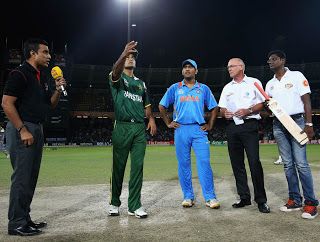
Pakistan enjoys warm up games and India is master at the World Cup
Which is the original Indian team? The one that beat England with an ease with their spin attack, the one that struggled against Australia with five bowlers, or the one that impressed greatly against Pakistan with only four bowlers?
The game started with the two different stats. One, that India had not won a single Super Eight game since their victorious efforts of 2007, and two, that India had never lost a game against Pakistan in any World cup game. It was battle of stats, to see which would remain true. In the end the second won. I wonder if India can play each World Cup game against Pakistan, as then they could lift each World Cup. It wasn’t the usual Indo-Pak clash with arguments on the ground, epic sledging, a tight finish and a heart-in-mouth contest, but was instead a rather simple one-sided contest.

Hafeez won the toss and probably repeated the mistake that India made in the last game by choosing to bat first. With four spinners in the side, it was expected to be difficult to bowl in the second innings, and the possibility of rain and dew only made it more difficult, as did Pakistan’s low score of 128.
After an unlike Dhoni experiment which included five bowlers including three spinners, the captain went back to his original theory, with which he was more comfortable with, playing seven batters and four bowlers, with a number of part-time options. India started with Zaheer Khan and Pathan, who are the side’s best new-ball bowlers. Pathan got a wicket with his in-swinging delivery in the very first over, which brought on Afridi, a surprise choice. He could have been demoted to number 11 after his first ball duck in the last game (and many other games as well), but Hafeez thought differently, probably due to Afridi’s record against India, and allowed him to play an innings at the top. But it didn’t work well, as he turned out to be the first of Balaji’s three wickets. In came the part-timers to complete the fifth bowler’s quota, but did much better than ‘the probable’ fifth bowler, going for just 37/3 in 6 overs. In fact, they allowed India to take control of the match in the middle overs. The death overs are a concern for India always, but India didn’t allow the match to slip this time, as the Ashwin-Balaji combination worked really well to keep the score down.
Pakistan needed an early wicket to have any hope of winning, and Raza Hasan provided that in the very first over by catching Gambhir’s ‘loft over bowler’s head and get four runs’ shot off his own bowling. To see two consecutive failures for Virat Kohli would probably require you to sit in a time machine and go a long time back, as it just does not happen nowadays. He came in and took on the bowlers with ease, scoring yet another 50. Sehwag on the other ahd n changed his game a bit and tried to stay on the crease for as long as possible, as India had a very low target to chase. Ajmal and Afridi couldn’t provide the kind of spin that Pakistan needed in the middle overs, probably due to their low target, and Viru and Virat allowed India to cruse to an easy victory.
Maybe India could have charged the bowlers after the first 6-8 overs and completed their chase quickly in order to improve their net run rate. However, if Pakistan loses to Australia, then India can afford to lose against South Africa by a very narrow margin, and if Pakistan wins the game, India will have to win by a slightly bigger margin than the margin of the Pakistan and Australia game. A simple-looking equation can turn out to be very difficult in the actual game though.